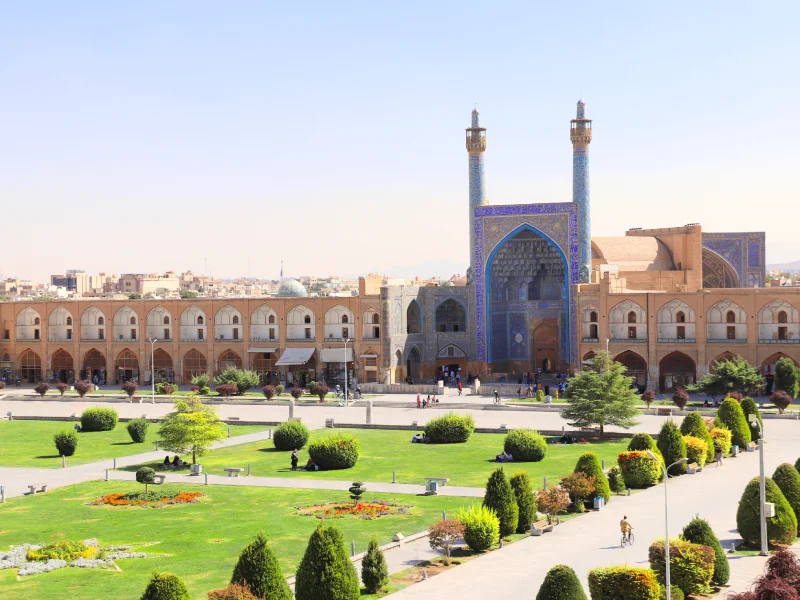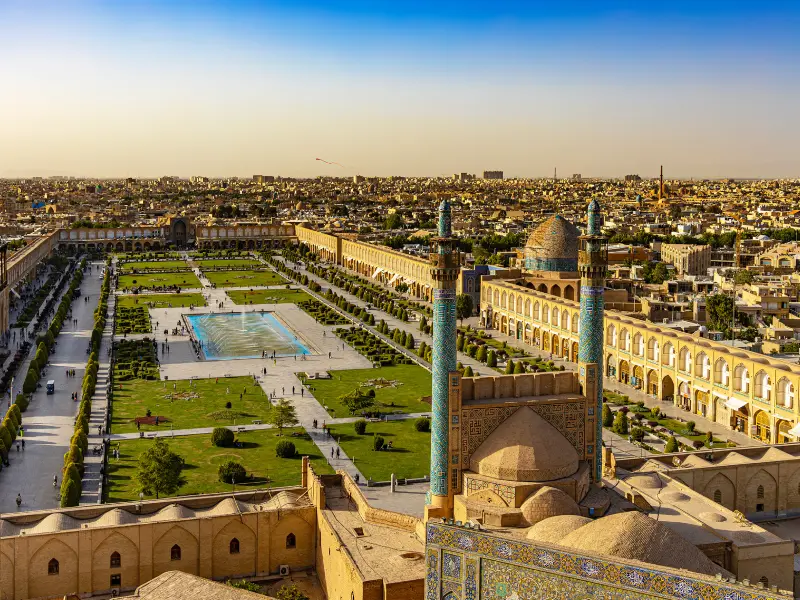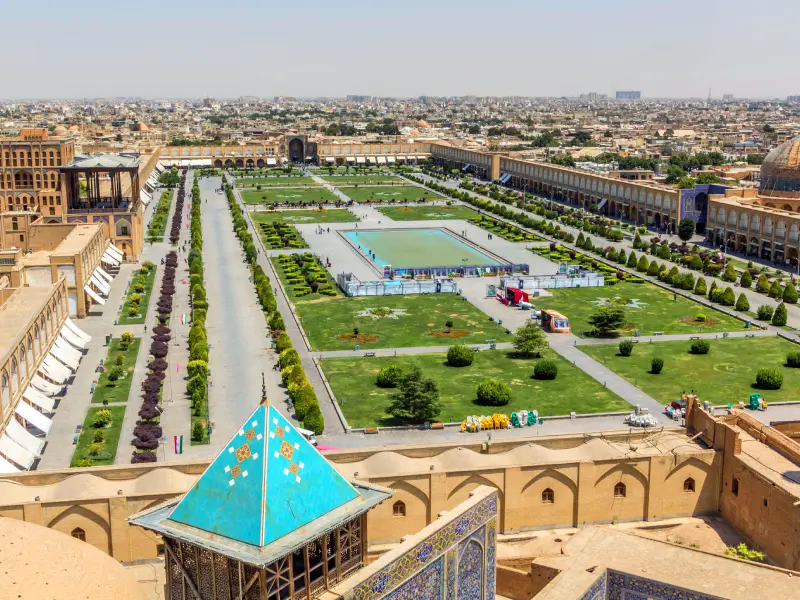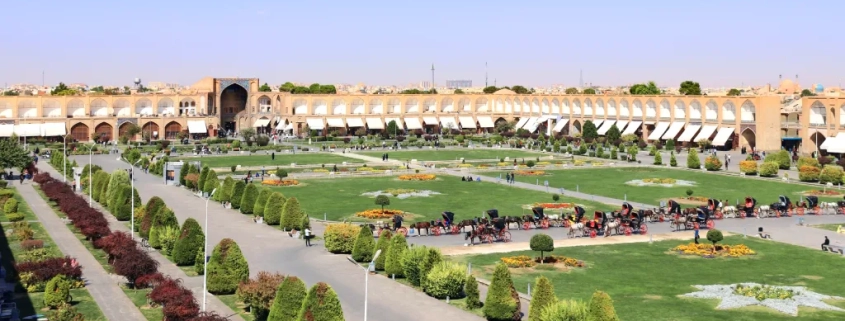Naqsh-e Jahan Square, Isfahan (Photos, Plan, Facts)
The historical city of Isfahan in Iran is always full of wonders, embracing one of the best in traditional touristic sights, bazaars, gardens, and souvenirs. Isfahan is a haven for visitors wanting to explore Middle Eastern culture and history. Inside this picturesque city, also known as “Half of the World,” is the largest square recorded in history titled Naqsh-e Jahan Square. Naqsh-e Jahan Square, or Imam Square of Isfahan, is one of the most significant tourist attractions and the central square of Isfahan. This large Square of Isfahan is inscribed in the UNESCO World Heritage list, which is why it has international fame and glory. Also, Naqsh-e Jahan Square is among the top things to do in Isfahan city, which hosts a large number of tourists every year.
About Naqsh-e Jahan Square
Naqsh-e Jahan Square of Isfahan is an outstanding historical complex in Iran and the world. Every year, this stunning square welcomes countless tourists who travel to Isfahan with the urge and passion to see the historical attractions and visit the beauty of the traditional square.
It is situated north of Isfahan. Naqsh-e Jahan Square was known as Shah Square before the Islamic revolution. However, today, it holds a new title of Imam Square.
On 1935 January 28, the large square was marked in the list of national monuments, and in 1979, it was also registered in the UNESCO World Heritage List.

Other historical and ancient monuments are also found in this square, making it an excellent location to spend time and discover more about Iran’s architecture and history.
When you visit Naqsh-e Jahan Square, you will get to encounter the charm and magnificence of Isfahan’s architecture. The presence of a large pond in the center of the square and various passages, religious attractions, and historical monuments have given this square a spectacular and special attraction.
Naqsh-e Jahan Square bazaars are always thriving, with travelers coming to purchase the popular souvenirs and handicrafts of Iran.
Naqsh-e Jahan Square History
Before the Safavid government (from 1501 to 1524) came to power, there was a large garden in the place of Naqsh-e Jahan Square, and in the middle section of the square called “Kushk Gate,” there were military buildings from the Timurid and Aq Qoyunlu periods. This section was the western part of today’s square, where the Ali Qapu Palace is now located.
Since the Seljuk reign, the square has been the place of national celebrations such as Nowruz (Persian New Year celebration) and the execution of convicts.
During the Safavid Empire, with the change of the capital from Qazvin to Isfahan, the era of glory and splendor of the square began, and its area became the location of government buildings and the Shah’s palace.
Abbas the Great, the fifth Safavid shah of Iran, aimed to expand the city towards its southern part on the border of the Zayandeh Rud River, and he established the first building of this square by employing skilled architects.

In terms of design and construction, Naqsh-e Jahan Square and its historical buildings have inspired the architectural style of other Iranian squares. Some prominent examples of this are Atiq Square in Isfahan, Amir Chakhmaq Square in Yazd, Shah Qazvin Square, and Sahib Abad Square in Qazvin.
The initial foundation of the current facade of Naqsh-e Jahan Square was built in 1598, and the construction of the square and its monuments were completed gradually in 1629. The work of decorating the mosque and structures began in 1612 and was later continued until the reign of two successors of Shah Abbas.
Monuments Inside the Naqsh-e Jahan Square
Shah Mosque is among the most visited historical sites of Naqsh-e Jahan Square in Isfahan, located on the south side of the square. The mosque has been the venue for many traditional gatherings and ceremonies since ancient times.
Sheikh Lotfollah Mosque has an eccentric dome that can be seen in the corner of the square, which will undoubtedly attract anyone’s attention. The mosque has no minaret. It is located on the eastern side of Naqsh-e Jahan Square, served as the religious center of Isfahan, and is still a cherished place to this day.
Aali Qapu Palace is situated in the west of Naqsh-e Jahan Square in Isfahan, which was considered a very important government center in the past. The infrastructure of this building is 1800 square meters, and it is built on six floors. The decorations of the palace are also very unique and always dazzling to the eye.
Qaysarieh Gate and Bazaar, which is the Isfahan Bazaar, is one of the largest and most beautiful markets in Iran. The construction of this flourishing bazaar took three generations, and it was made during the Safavid and Qajar eras.
Naqsh-e Jahan Square Facts
Before the Safavid period, there was a beautiful garden named Naqsh-e Jahan in this square. Naqsh-e Jahan was the name of a city in Azerbaijan, which today has changed to Nakhchivan.
The dimensions of this square include 560 meters in length and 160 meters in width. It has an area of 89,600 square meters (964,000 sq ft)). Naqsh-e Jahan Square can be compared with Moscow’s Red Square.

Dating back to the Safavid era (1501-1736), the square is home to the Shah Mosque, Sheikh Lotfollah Mosque, the Ali Qapu Palace, and the Isfahan Grand Bazaar. This interplay of architectural marvels makes it a significant UNESCO World Heritage site.
Aali Qapu Palace is the most magnificent palace in Naqsh-e Square and in the world. The outstanding decorations of the floors, the sound reflection at the entrance of the palace, the reception hall, and the main music hall make this palace stand out.
The Qaysarieh Bazaar Gate, which is the main entrance (Sardar) to the Bazaar of Isfahan, is one of the most renowned buildings of the Safavid period, which you will come upon when visiting the square. This historical structure had three floors. However, due to old age, the floor that was used as a music hall was destroyed.
Naqsh-e Jahan Square Reviews
When you come across the Naqsh-e Jahan Square photos, you can observe the extraordinary historical site that captivates visitors with its magnificent architecture and antique yet lively atmosphere.
Travelers have praised the square for both its historical elegance and lively contemporary use. It’s not just a static museum piece. You can see families picnicking, local artisans displaying their crafts, and vibrant marketplaces that imbue it with a unique manner.
The square provides a variety of experiences, from enjoying the local cuisine at nearby restaurants to taking horse-carriage rides around the complex. For the photographers among us, the square offers numerous photo opportunities, particularly during sunset or nighttime when the square is beautifully illuminated.
Final Word
Naqsh-e Jahan Square is not only an architectural jewel but also a lively center of cultural activity. It might just be worth a visit to soak in both its historical atmosphere and colorful and savory souvenirs. It offers a pleasant environment filled with locals and tourists enjoying the gardens, fountains, and cultural events. This location is ideal for history enthusiasts, architecture admirers, and cultural explorers alike. The square also provides a deep sense of historical experience since it is rich in tradition and perfect for photography.
Are you planning to travel to Iran and looking for an Iran resort? Consider Matinabad Eco-resort.





Leave a Reply
Want to join the discussion?Feel free to contribute!